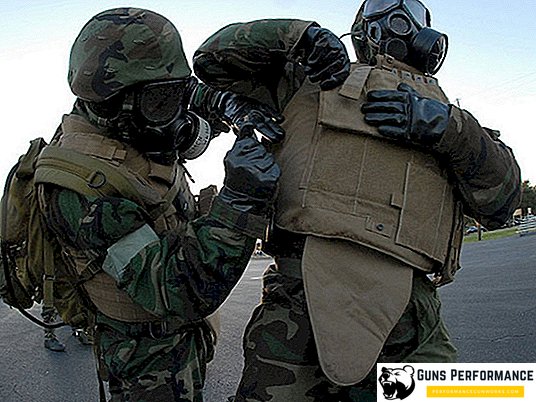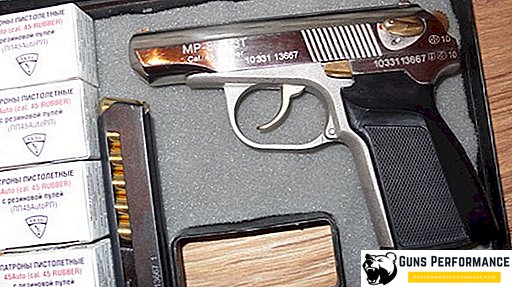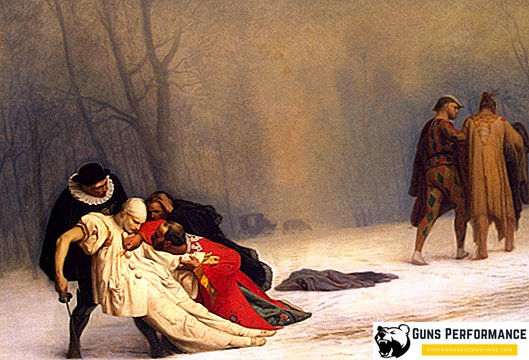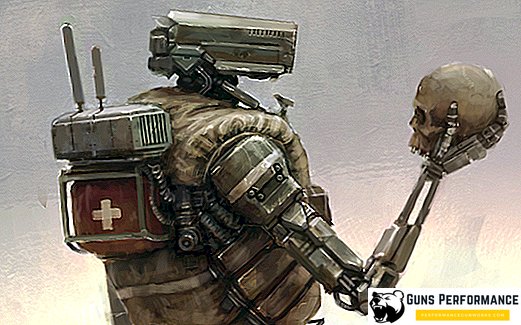
The Yak-1 is a Soviet piston fighter of the Second World War period. It became the first combat vehicle developed in the Yakovlev design bureau, and marked the beginning of a whole series of aircraft that became the basis of the Soviet fighter aircraft during World War II.
Fighter Yak-1 was adopted in 1940, its production continued until 1944. During this period, more than 8.7 thousand aircraft were built and several modifications of this combat vehicle were developed.
Haste, which began mass production of the aircraft, led to many flaws in the design of the Yak-1. However, despite this, the pilots loved this car. The Yak-1 began to beat the enemy from the first days of the war. This fighter was easy to operate and fairly unpretentious to maintain, and its high performance allowed it to withstand the German Bf.109 and Fw.190.

Such famous Soviet aces as Pokryshkin, Koldunov, Alelyukhin, Ahmet-Khan Sultan fought on the Yak-1. It was on this plane that the pilots from the famous Normandy-Neman regiment entered the battle.
On the Yak-1, the only female fighter air regiment in the Red Army (586th IAP) fought, which can be called a confirmation of the ease of this car for the pilot.

History of creation
At the end of the 1930s, it became clear that the Soviet aircraft fighter fleet was outdated and urgently needed updating. The country's air forces needed a new high-speed fighter that could compete on an equal footing with foreign counterparts. Polikarpovskiy I-16 was a real "star" of the mid-30s, and the USSR was the first country in the world to adopt a high-speed monoplane fighter.
"Ishachok" (so affectionately called the pilots I-16) for a long time had no equal in the sky of Spain, until in 1937 the newest German fighter Bf.109 was sent there. It cannot be said that the first series Me-109 was an ideal machine, but it was a new aircraft and had a significant modernization resource, which I-16 was almost completely exhausted. In the 1930s, aviation developed rapidly, the aircraft, launched five years ago, was considered obsolete. Despite the relatively small difference in the release date, the German Bf.109 could be safely called the next generation fighter.
Several design teams began working on the creation of a new fighter: under the leadership of Lavochkin, Yakovlev and Polikarpov. True, in 1940, the design bureau was taken away from the latter along with an almost finished aircraft, which later became the MiG-1.
At that time, the leadership of the Soviet Air Force believed that the main air battles would take place at high altitudes, so designers were required to create fighters capable of showing their best performance at a height of at least five kilometers. The maximum speed of the future car was supposed to be about 600 km / h, the landing one was 120 km / h, the ceiling was 11-12 km, and the maximum range was at least 600 km.
In those years, a serious problem facing the domestic aviation industry, were engines. With their development in the USSR, serious problems arose, many aircraft engines were manufactured by the Soviet industry under license, but it was becoming more and more difficult to receive them before the war. Also in the USSR there was a serious shortage of Dural. A large number of it went to the manufacture of heavy bomber, the designers of small fighters and attack aircraft had to use wood, plywood and canvas in the design.
Yakovlev Design Bureau began to design the fighter in May 1939, before the designer was engaged in the creation of sports and training aircraft. The new machine was created on the basis of the sports aircraft I-7, the work was carried out at the plant number 115.

The prototype fighter received the designation I-26, its first flight took place on January 13, 1940. At the helm was test pilot Yu. I. Piontkovsky. During the second flight, an accident occurred, the pilot died, and the car crashed. It later turned out that the disaster was due to a manufacturing defect. However, despite the catastrophe, no one doubted that the new aircraft was really good.
It was decided to launch the I-26 into mass production even before the end of state tests. The fighter received the designation Yak-1.
At this time, a world war was already raging in Europe, so the desire to quickly get a new fighter is understandable, but the rush led to the fact that the production aircraft turned out to be very “raw” and many modifications to its design had to be made right during production. This led to constant changes in the working drawings, the manufacture of new equipment, and sometimes to the alteration of ready-made components and assemblies built aircraft.
Serious improvements demanded the oil system, the chassis design was changed, which was very hot during braking. The aircraft’s air system, engine and armament also needed to be refined.
In September 1940, the military accepted the first batch of ten new cars, after which they were immediately sent for military trials. On November 7, 1940, five Yak-1 fighters took part in a parade on Red Square. At this very time, the aircraft were in full swing at the factories: only from June 1940 to January 1941 more than 7 thousand changes were made to the drawings of the machine.
By the beginning of the war, Soviet industry was able to manufacture a little more than four hundred Yak-1, but not all of them were accepted by the military. Only part of these aircraft were in the western military districts and were mastered by pilots.

Interesting is the fate of the other fighters who participated with the Yak-1 in the pre-war competition. All of them were put into service and put into mass production. However, the war very quickly put everything in its place.
The Mikoyan MiG-1 (and MiG-3) was a pretty good fighter, but it showed its best qualities at considerable heights (from 5 km), but the main battles on the Soviet-German front usually went much lower. In addition, this machine had a rather weak weaponry. So soon its production was discontinued, and the existing vehicles were transferred to the air defense.
Even shorter was the combat path of the fighter LaGG. Designer Lavochkin's car was completely made of specially treated delta wood ("Lacquered Coffin Guaranteed" - so it was called at the front). After the start of the war, this plane began to be made from ordinary pine, which led to a significant increase in its mass. This made it even worse and not so brilliant. The leadership of the country, seeing this situation, ordered the production of LaGGovs to be stopped, and the released capacities to be given for release by Jacob.
The first one and a half years of the war, the Yak-1 was clearly the best Soviet fighter at the front. Simple, cheap, easy to operate, the Yak-1 fighter had good flight characteristics and powerful armament. The largest number of fighters was released in 1942 - more than 3.5 aircraft.
In the summer of the same year, the production of the Yak-1b aircraft began - versions with a more powerful forced M-105PF engine. This allowed the fighter to accelerate to almost 600 km / h and perform a turn in 19 seconds. In addition, the aircraft was reinforced: now it consisted of a UB machine gun (12.7 mm) and two ShVAK automatic guns (20 mm). After modernization, the Yak-1 was able to adequately fight with the German Me-109 last modifications. The strength of the Soviet aircraft was a battle on the horizontal, in vertical maneuvers the Me-109 was superior to the Yak-1. In addition, some changes were made to the design of the fighter: he received a new flashlight, which provided a sufficient overview of the rear hemisphere, as well as the front armored glass.
Production of the Yak-1 was completed in July 1944, already made the machine for some time delivered to the troops. Operation of the Yak-1 continued until the very end of the war.

Description of construction
The Yak-1 fighter is made according to the normal aerodynamic configuration; it is a low-wing monoplane with a semi-monocoque fuselage. The aircraft was equipped with retractable landing gear.
The design of the aircraft was mixed, that is, it consisted of both metal and wood with a canvas. The power frame of the fuselage consisted of steel pipes, which made a single whole with the motor frame. Parts of the frame were joined by welding. The main elements of the power frame of the car were four spars connected by ten frames.
Between the first and second frame was a cockpit cockpit, the frame of the lantern was welded to the upper spars. In the same compartment were the docking units of the fuselage and wing.
Covering the front of the fuselage was made of duralumin, back - from the canvas. The nose of the car was closed by the hood, on the machines of the first series it had side openings ("gills") through which the engine was purged.
At the rear of the aircraft, gargroves were installed on the fuselage above and below, which improved its aerodynamic characteristics. The upper gentle gargrot from the cockpit to the keel was a characteristic feature of the appearance of the Yak-1. This design solution improved the aerodynamic qualities of the fighter, but significantly worsened the rear hemisphere for the pilot, so the upper gargrot and the cockpit lantern were altered on the Yak-1b modification.

The wing of the fighter was made of wood, it had a trapezoidal shape with rounded ends. The power frame of the wing consisted of two spars and a set of ribs and stringers. The wing skin is working, it was made of bakelite plywood and linen. The aileron and landing pads, the flaps covering the landing gear niches, and the winged faces were made of duralumin.
The cockpit was closed by a lamp made of plexiglass, its middle part shifted back in special poloski. The pilot's seat was protected by a 9 mm thick armored boot. On the modification of the Yak-1b fighter, the rear part of the flashlight was made in the form of a glass cap, which significantly improved the visibility of the rear hemisphere, and armored glass was installed at the front. The late series of the aircraft was equipped with a flashlight emergency reset system, which allowed the pilot to quickly leave the car. The pilot's seat had a parachute cup.
The tail of the fighter also had a mixed design, the stabilizer and the keel were made of wood, and the rudders and heights were made of duralumin. All wheels were equipped with trimmers. Steering steering took place through a cable pull.
Yak-1 had a tricycle retractable landing gear, consisting of two main racks and tail support. The chassis of the fighter had oil-air damping and air shoe brakes. The main landing gear retracted to the wing toe toward the fuselage of the car. Racks were cleaned using a pneumatic system. In flight, the niche under the landing gear closed with two shields. The tail landing gear was non-retractable with a caster wheel. On the Yak-1, it was possible to install a ski chassis.
The power plant of the aircraft consisted of an M-105P water-cooling engine, which in the later series was replaced with more powerful M-105PA and M-105PF motors. Screw Yak-1 three-blade, variable pitch. In front, it was closed by easily removable cork, which had a characteristic streamlined shape.

Engine control (gas, switching speeds, the work of the injector) was carried out with the help of cables. Starting the engine produced by compressed air.
The fuel was supplied by a gasoline pump, which was driven by the engine of the aircraft. The fuel system of the Yak-1 consisted of four gas tanks with a total capacity of 408 liters, they were placed in the wings of the car. All tanks were retrofitted and equipped with gasoline.
The oil system had a tank with a capacity of 37 liters, the cooling radiator was located in front of the aircraft in a special tunnel under the engine. The Yak-1 had a closed type engine cooling system; the coolant was water, to which antifreeze was added at low temperatures. The water radiator was located in a tunnel under the wing of the aircraft.
The equipment of the cockpit of the Yak-1 consisted of an altimeter, speed indicator, rotation, boost indicator, water temperature sensor, AVR hours. From the radio equipment on the plane was installed receiver "Baby", the transmitter "Eagle" and the radio compass.
The armament of the Yak-1 fighter consisted of a 20-mm ShVAK cannon, which was installed in the collapse of the engine, fired through the sleeve of the gearbox and the hollow shaft of the screw, as well as two ShKAS machine guns (7.92 mm) located on the sides of the fuselage. The aircraft was equipped with a synchronizer, which excluded the possibility of bullets falling into the propeller. The gun and machine guns had both pneumatic and manual reloading. On the modification of the Yak-1b ShKAS machine guns were replaced by a more powerful UB machine gun of 12.7 mm caliber.
The ammunition of the machine guns included armor-piercing incendiary, explosive, armor-piercing incendiary tracer and sighting cartridges.

Efficiency and combat use: fighter assessment
Yak-1 entered the battle from the very first day of the war. At the beginning of the conflict, this aircraft was the best fighter that the Red Army had. One of the main problems with the Yak-1 - as well as with many other aircraft of the Soviet Air Force - was its poor manpower. It was a new machine, which began to appear in the military units just a few months before the outbreak of war. To retrain for the new fighter the pilots had already during the fighting.
It should be noted that the Yak-1 was very "friendly" to the pilot, easy to operate, there were no problems with it during takeoff and landing. After a very strict and difficult piloting of the I-16, flying the Yak-1 was just a pleasure. In conclusion, which the test pilots wrote about the new car, it was indicated that it was “available to a pilot with below-average qualifications”. However, it’s one thing to just lift the plane and land it, and quite another to stand in the air for German pilots on the Bf-109, which is rightly called one of the best fighters of the Second World War.

The Me-109 was the main opponent of the Yakovlev fighter. The Yak-1 of the initial period of the war was heavier than the Bf-109E and had a less powerful engine, it lost to its German opponent in rate of climb and speed, but this lag was not as significant as the I-16.
The problem was not only the lag in the basic flight performance, but also a large number of “childhood” diseases that were characteristic of the Yak-1 fighters of the first series. Haste with the introduction of the machine into production did not pass without a trace. Here is the main list of technical problems that were characteristic of the Yak-1:
- Frequent overheating of oil and water when the power plant is operating at rated power. Spraying oil through poor engine seals. In flight, the whole fuselage of the fighter, up to its tail, could have been smeared with oil. But the biggest problem was getting oil on the cockpit canopy, so that the pilot simply did not see anything. Almost all the pilots who fought on it tell about this "feature" of Yak.
- Fuel from different tanks was produced unevenly.
- The aircraft’s pneumatic system was often leaking.
- Frequent distortions and jamming of machine gun cartridge belts.
- Vibration caused the housing screws to self-eject.
A few words should be said about the problems with the fighter’s oil system. Oil leaks not only caused the machine body to spatter, but also worsened the operation of the engine cooling system. Therefore, the pilot had to periodically slow down the gas and cool the engine; in a real battle, such a deficiency of the aircraft could cost the pilot life. It should also be noted that at the beginning of the war, the Yak-1 did not have a walkie-talkie, it was only installed in 1942.
Gradually, the fighter got rid of most of its shortcomings, but no one can say how many pilots paid with their lives for the decision to adopt a flawed machine.

To be honest, for almost the entire war the Yak-1 was inferior to its main opponent Me-109. German designers also did not sit on their hands, the Messers were constantly modernized and improved. True, the late modifications of the Me-109 had a considerable mass and could no longer compete with the Yak-1 in terms of maneuverability.
It should be remembered that the outcome of the air battle was often decided not by the characteristics of the aircraft, but by the skills of the pilot and the adequate tactical use of fighters. At the initial stage of the war, this was a problem, but with each month of fighting, the Soviet Air Force gained experience, and the situation gradually leaned toward them.
There is one more thing: on the scale of such gigantic conflicts, as was the Second World War, the characteristics of a separate aircraft (as well as of other types of military equipment) are not the most important thing. It is important to be able to quickly make up for losses in equipment and personnel. In this regard, the Soviet Union beat Germany outright. Намного выгоднее иметь сотню средних летчиков, чем десяток асов, и дешевый, простой истребитель Як-1 с немного худшими характеристиками, чем дорогой и ресурсоемкий Ме-109. К преимуществам истребителя Як-1 можно смело отнести следующее:
- низкая стоимость и простота в производстве;
- полное соответствие конструкции истребителя технологической базе, имеющейся на тот момент в СССР;
- приемлемые летно-технические характеристики самолета;
- простота в пилотировании и доступность для пилотов военного времени, которых обучали по ускоренной программе;
- значительный модернизационный ресурс;
- неприхотливость в обслуживании и высокая ремонтопригодность;
- широкая колея шасси, что делало возможным использования аэродромов с грунтовым покрытием.
Исходя из всего вышеперечисленного, не удивительно, что Як-1 стал одним из самых массовых истребителей Второй мировой войны.

Specifications
Ниже указаны ЛТХ истребителя Як-1:
- размах крыла - 10 м;
- длина - 8,48 м ;
- высота - 1,7 м;
- площадь крыла - 17,15 кв. м.;
- масса нормальная взлетная - 2700 кг;
- тип двигателя - М-105ПФ;
- мощность - 1180 л. с.;
- Max. скорость, км/ч - 592;
- практическая дальность - 850 км;
- Max. скороподъемность - 926 м/мин;
- практический потолок - 10000 м;
- экипаж - 1 чел.












